19 Unusual Houseplants to Grow at Home
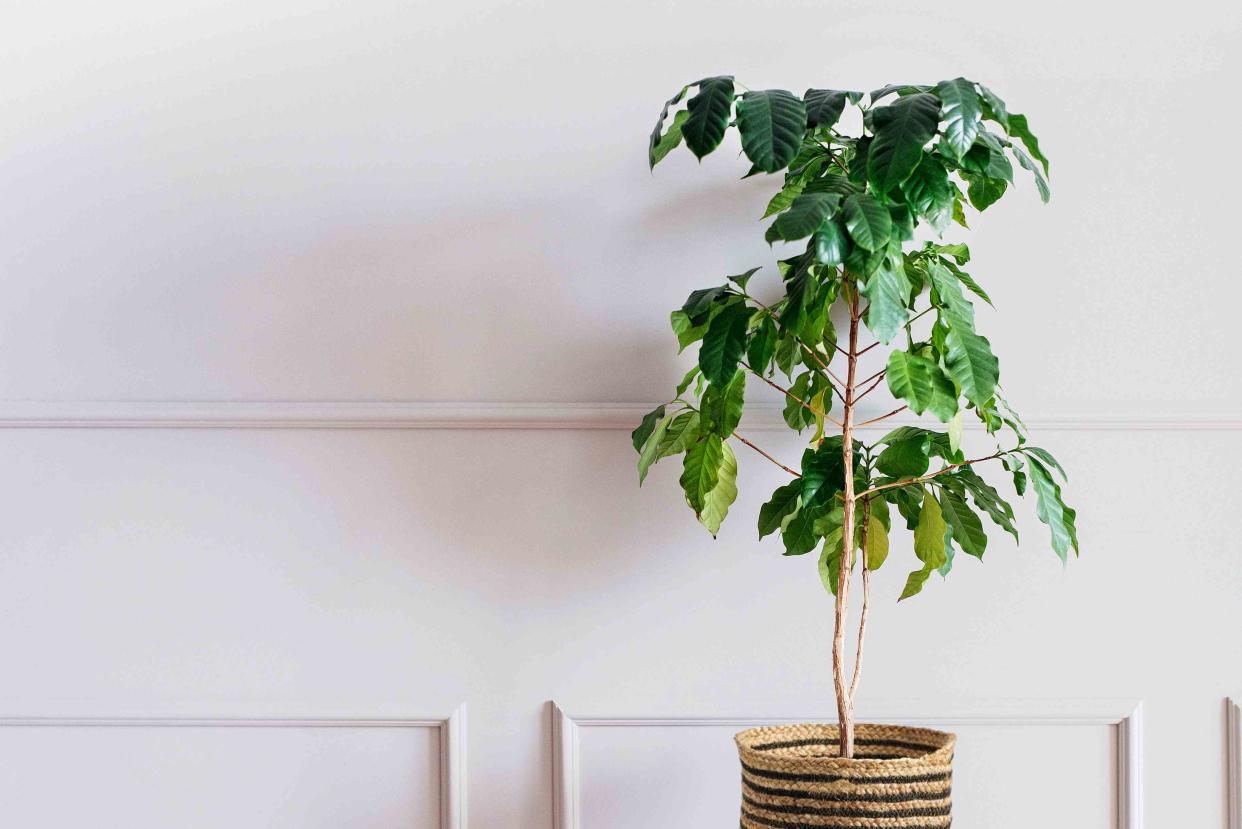
The Spruce / Ulyana Verbytska
The world of houseplants is much grander than the selection at your local home improvement store would lead you to believe, and many different varieties of unusual houseplants spruce up your collection. Thanks to online plant purveyors and the legwork of plant collectors who scour remote regions looking for new specimens and unique and rare houseplants for our homes, you can cultivate plants that are normally found only in places like Madagascar or South Africa.
Although these plants may be unusual because they have different shapes, colors, flowers, and growing habits to choose from, they are no more difficult to grow indoors than any of the other most popular plants. Read on for 19 of the coolest houseplants that are fun to watch and grow.
Warning
Though many of the featured succulents are not toxic, be sure to check other unique succulents you might choose to grow as houseplants which are potentially toxic to pets, such as jade plants (Crassula ovata) and pencil cactus (Euphorbia tirucalli).
Desert Rose
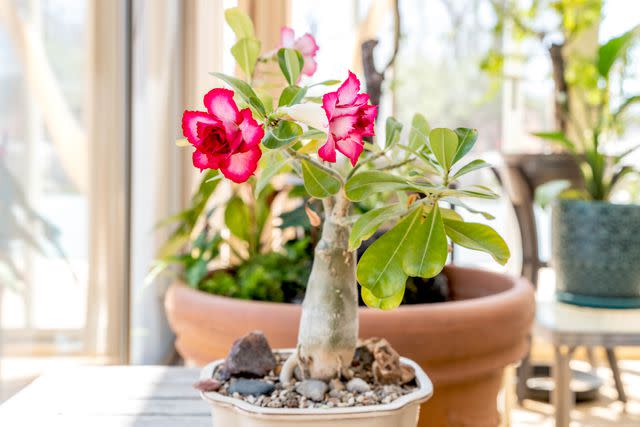
The Spruce / Adrienne Legault
The desert rose grows in the arid regions of Africa and the Middle East. True to its name, the desert rose thrives in hot, dry conditions. Although the plant resembles a bonsai tree in form, the swollen trunk is an adaptation for storing water in drought conditions. Give your desert rose high levels of light and good drainage. It's natural for plants to enter dormancy in the winter, so don't be alarmed if leaf drop occurs. Keep it in a cool sunny window and when outdoor temperatures rise above 70 degrees Fahrenheit, give it a vacation on the deck to spur new growth. Desert rose is toxic to humans and animals.
Name: Desert rose (Adenium obesum)
Light: Full sun
Water: Keep moist when growing, reduce to once monthly when dormant
Soil: Sandy, cacti soil, well-drained
Banana Shrub

The Spruce / K. Dave
The banana shrub is named for its sweet tropical scent, but it is not related to the fruiting banana tree. Michelia figo plants are a member of the magnolia family and exhibit similar cup-shaped blooms on compact shrubs that usually don't exceed three feet in container culture. The banana shrub is a middle-of-the-road plant in all of its needs; provide it with partial sun, moderate watering, and average room temperatures, and it should thrive.
Name: Banana shrub (Michella figo)
Light: Bright, direct sunlight
Water: Water well and let top 1-2 in. of soil dry out before watering again
Soil: Slightly acidic, well-draining medium such as African violet mix with peat moss
Climbing Sea Onion
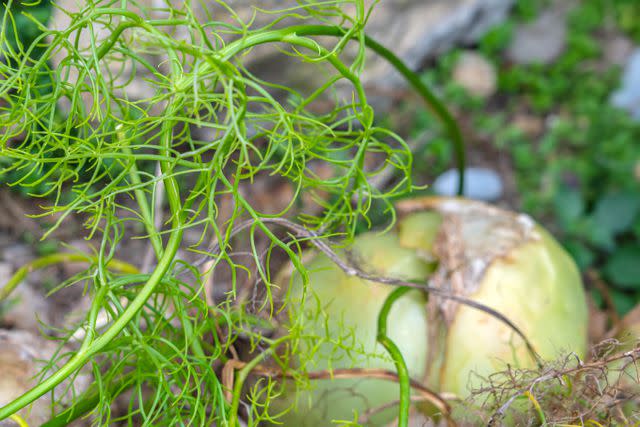
The Spruce / Evgeniya Vlasova
The climbing sea onion is a great specimen for those new to houseplants, as it tolerates a wide variety of environments and shrugs off neglect. The bulb puts out vigorous shoots of lacy foliage in the spring and goes dormant in the fall. Climbing sea onions need a small trellis to support their growth. Give your climbing sea onion full sun and keep it moist but do not overwater.
Name: Climbing sea onion (Bowiea volubilis)
Light: Bright, direct sunlight
Water: Keep soil consistently and moderately moist but not soggy
Soil: Gritty, well-draining soil such as cactus mix
Club Moss
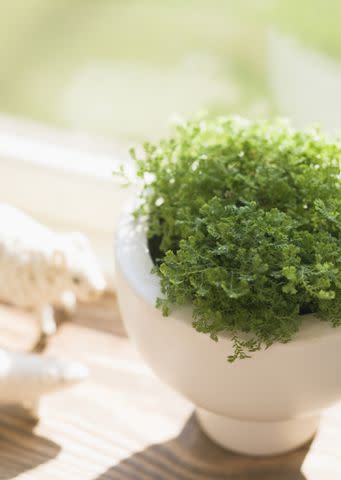
imagenavi / Getty Images
Club moss is a tropical moss that has a low profile so it fits nicely into contemporary decor. This plant does well in low light conditions, but it requires a humid environment to thrive. This is the perfect plant for a mini-terrarium where it will add cheer to your windowsill throughout the seasons.
Name: Club moss (Selaginella kraussiana)
Light: Moderate light, keep out of direct sunlight
Water: Keep lightly and consistently moist with room-temperature water
Soil: Peat moss and perlite potting mix, well-draining
Coffee Plant
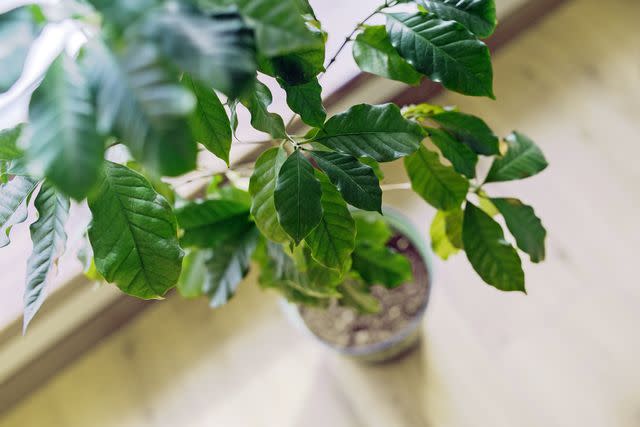
The Spruce / Ulyana Verbytska
The coffee plan is indeed the same plant that keeps you in java, although you might get a caffeine headache waiting for enough berries to mature on your coffee plant for a viable harvest. Sporting attractive glossy green foliage, the coffee plant is a member of the gardenia family–and it's often confused with the coffee tree (Polyscias guilfoyei)–so expect fragrant white flowers to precede the red berries that yield coffee beans.
Coffee plants appreciate humid conditions and moderate light. Plants may grow quite large, but if you prune them back severely, they will grow back to flowering size within a year. The coffee plant is toxic to humans.
Name: Coffee plant (Coffea arabica)
Light: Partial sunlight
Water: Ample watering but do not keep soil soggy
Soil: Acidic, peat-based potting soil, moist
Lifesaver Plant
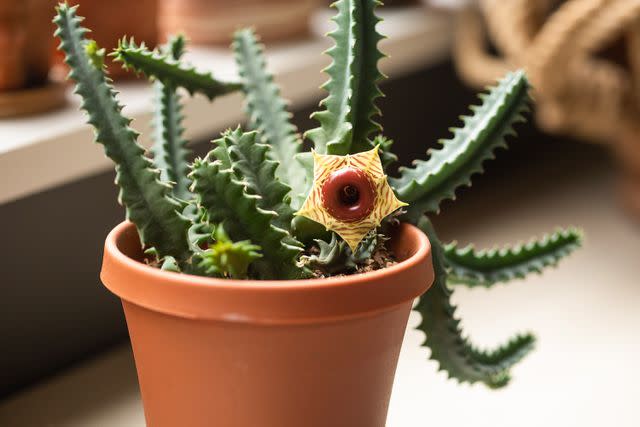
The Spruce / Phoebe Cheong
Lifesaver plant, also called owl eyes, is one of the strangest-looking plants to add to your collection. The waxy flowers look like plastic, but these very real plants are native to South Africa. Like other members of the cactus family, lifesaver plants need sandy soil and some sun for the best vigor. Keep the petite plants on a windowsill to admire their strange anatomy up close.
Name: Lifesaver plant (Huernia zebrina)
Light: Bright light with partial shade but never direct sunlight
Water: Water only when top inch of soil is dry, avoid overwatering
Soil: Sandy, cactus, or succulent potting mix
Cement Leaf Plant
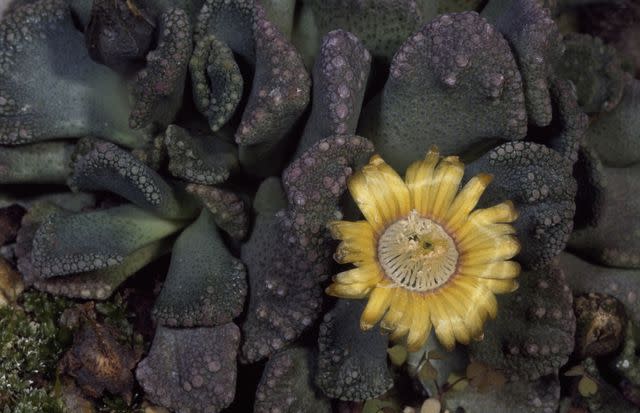
De Agostini Picture Library / Getty Images
Cement leaf, also known as concrete leaf, jewel leaf, limestone rock plant, and carpet leaf, is a mat-forming succulent oddity with unusually thick, fleshy, and bumpy leaves thought to be the plant's camouflage. The plant needs rocky soil and bright light conditions like that of its native South Africa. If you're lucky, your Titanopsis calcarea may even produce a yellow bloom among its warty leaves in the winter months.
Name: Cement leaf (Titanopsis calcarea)
Light: Bright sunlight but some shade in the summer
Water: Water well in spring, sparingly in summer when dormant
Soil: Sandy cactus mix, well-draining
Sensitive Plant
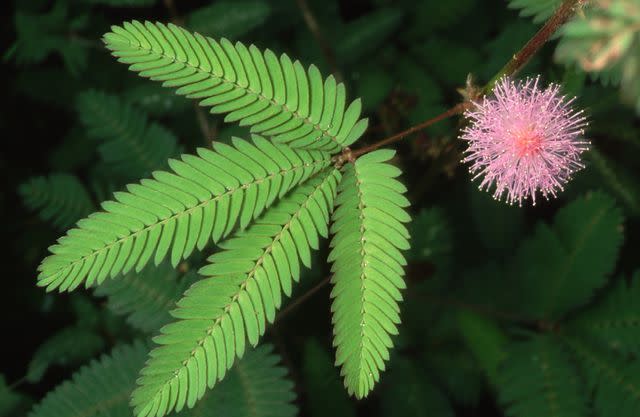
Kevin Schafer / Getty Images
The sensitive plant, also called the shy plant, is a creeping shrub known for its delicate purple pompom flowers and intriguing leaf movement. The sudden movement of its leaves is a response to touch and is a function of water movement in the plant cells. The sensitive plant is considered a weed in tropical areas; lots of sun and moderate watering will yield successful results for this fun and unusual houseplant.
Name: Sensitive plant (Mimosa pudica)
Light: Bright sunlight
Water: Keep soil moist but never soggy, reduce watering in the winter
Soil: Loamy, well-draining
Bat Flower
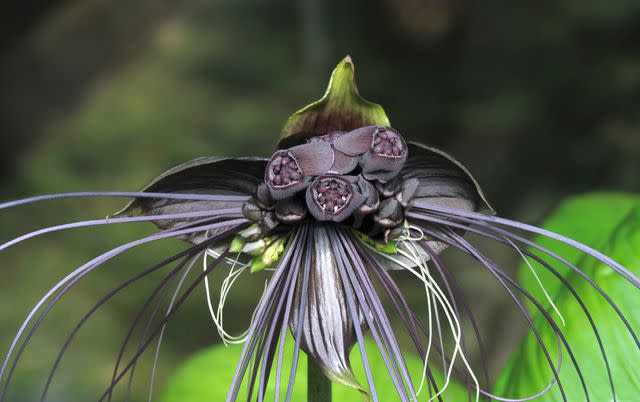
Gueholl / Getty Images
Bat flowers are one-of-a-kind with their moody dark petals and long whiskery growths categorized as bracteoles, which are thin specialized bracts growing from the flower stalk. There's also a white bat flower (Tacca integrifolia). If you area able to grow an orchid, you can grow a bat flower. They both love filtered light, high humidity, and excellent air circulation.
Name: Bat flowers (Tacca chantrieri)
Light: Partial, dappled sun
Water: Keep soil consistently moist not soggy
Soil: Rich, well-draining
California Pitcher Plant

The Spruce / K. Dave
California pitcher plant, also known as cobra lily, is called that because its curling, dramatic leaves resemble the heads of cobra snakes. This one-of-a-kind plant also feasts on insects (not fertilizer) because it's a carnivorous self-feeding plant. Indoors, your pitcher plant may ingest and dissolve stray ants, spiders, flies, crickets, moths, and even tinier insects. This plant prefers cooler temperatures to keep roots from heating up, so choose a lighter-colored pot.
Name: California pitcher plant (Darlingtonia californica)
Light: Full, bright sun but not scorching
Water: Keep soil slightly moist with rainwater or spring, purified, or distilled water but not tap water
Soil: Airy but rocky, organic potting mix
Sundew
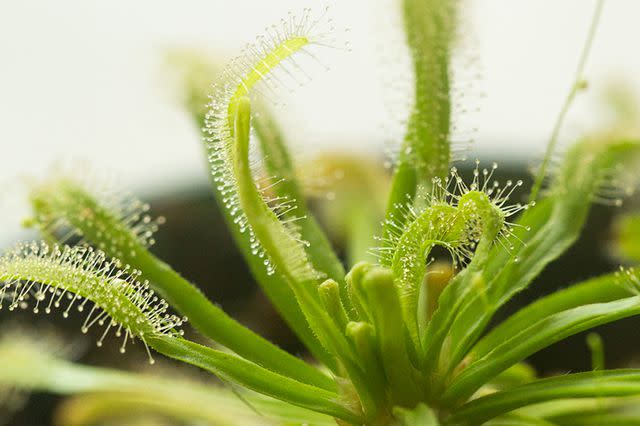
The Spruce / Phoebe Cheong
Sundew is another carnivorous plant that lures insects into hairy tentacle-like green leaves that are covered with scented mucus. But this bloodthirsty houseplant also blooms small white or pale pink flowers. This plant loves a warm, moist, and humid environment indoors.
Name: Sundew (Drosera capensis)
Light: Full sun but partial may be fine
Water: Use distilled water or rainwater to keep moist but do not use tap water
Soil: A mix of vermiculite and/or perlite, peat moss, and some composted potting soil
Jewel Orchid
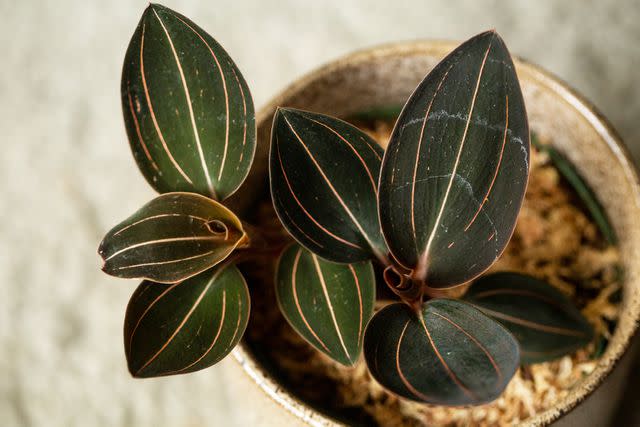
The Spruce / Phoebe Cheong
Jewel orchid is a rare tropical plant native to the forest floors of Southeast Asia and known for its large and uniquely pinstripe-patterned leaves and white flower stalks.
Cultivars offer varied colored leaves, such as Ludisia discolor ‘Nigrescens' and its velvety, maroon-black leaves with pink pinstripes or Ludisia discolor ‘Alba’ with bright green leaves and white detailed veins.
Jewel orchids are considered terrestrial orchids, which grow on the ground rather than in trees, like other orchids, but still need moderate to high humidity levels indoors.
Name: Jewel orchid (Ludisia discolor)
Light: Bright but indirect sun
Water: Keep lightly moist and add water when top inch is dry, about every seven to 10 days
Soil: Part orchid potting mix, part perlite, part peat moss, well-draining
Venus Flytrap
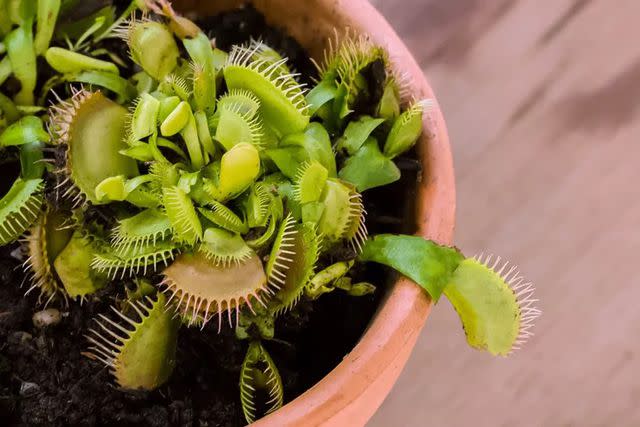
The Spruce / Kara Riley
The Venus flytrap is a classic carnivorous houseplant and it's also one of the most unusual-looking plants that's tons of fun to watch. The "trap" of the plant is a modified leaf with two lips that trap flies with nectar in its mouth. Once inside, the insect is digested via enzymes within about a week and then the lips reopen. But don't worry, the Venus flytrap's trap isn't strong enough to hurt you or your pet. It's best to stay clear of the plant's trap, though, to let it focus its energy on catching and digesting prey rather than trying to dissolve your finger.
Name: Venus flytrap (Dionaea muscipula)
Light: 12 hours of bright light in the spring through fall then reduce to four hours of light in the winter
Water: Use rainwater but not tap water to keep soil moist
Soil: Acidic soil mix with peat moss
Cooper's Haworthia
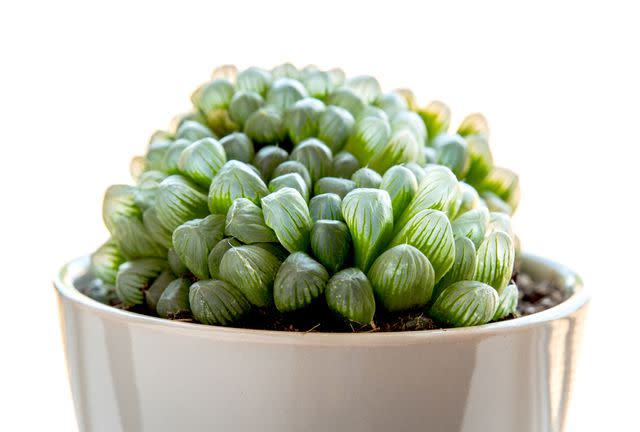
The Spruce / Adrienne Legault
Cooper's haworthia is a low-maintenance succulent featuring fleshy, transparent, triangular, or rounded tips on compact green or blue-green leaves that grow in rosettes. Like many succulents, Cooper's Haworthia is somewhat forgiving if you forget to water it. This succulent actually prefers fresh air and low humidity. This plant is slow-growing so you don't have to worry about regular repotting.
Name: Cooper's haworthia (Haworthia cooperi)
Light: Bright indirect sunlight
Water: Use room-temperature water when soil is completely dry to the touch, do not leave standing water
Soil: Cactus mix with some coarse sand for loose, best drainage
Living Stones
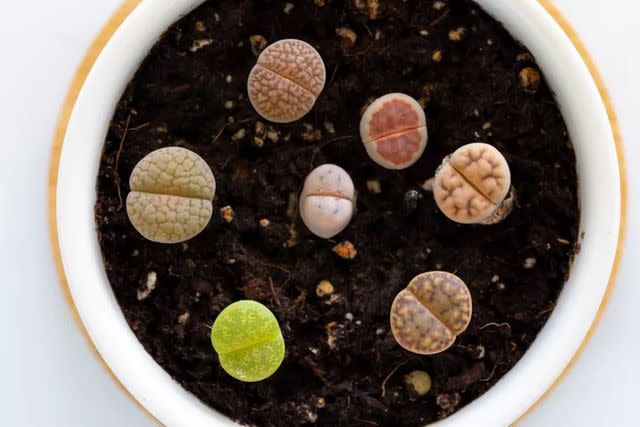
The Spruce / Anastasiia Tretiak
Living stones, also called pebble plants, are uncommon succulents that look like colorful little rocks. The plants are native to Africa and are extremely slow growers that only pop up about an inch high from the soil. These little rock-like plants naturally split and scar, but that only means they are growing.
These plants need as much light as possible and a seasonal watering regime to thrive. Indoor living stones may need to be put under an artificial grow light if you don't have a window with enough bright light.
Name: Living stones (Lithops spp.)
Light: Bright sunlight
Water: Seasonal watering schedule required
Soil: Well-drained, cacti potting mix
Lavender Scallops
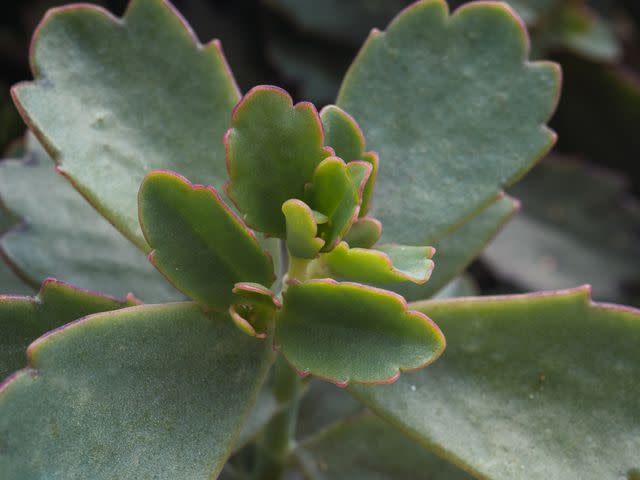
Getty Images/Dani VG
Lavender scallops are charming little succulents that are easily identifiable by the vibrantly colored pink and lavender border along their variegated, scalloped leaves. Despite its dainty appearance, Lavender scallops is an easy-to-grow succulent that has low water needs, reproduces easily, and is vulnerable to very few pests or diseases.
Name: Lavender scallops (Kalanchoe fedtschenkoi)
Light: Part sun to part shade
Water: Let dry out between waterings, water sparingly during colder months
Soil: Well-drained, sandy
Pencil Cactus
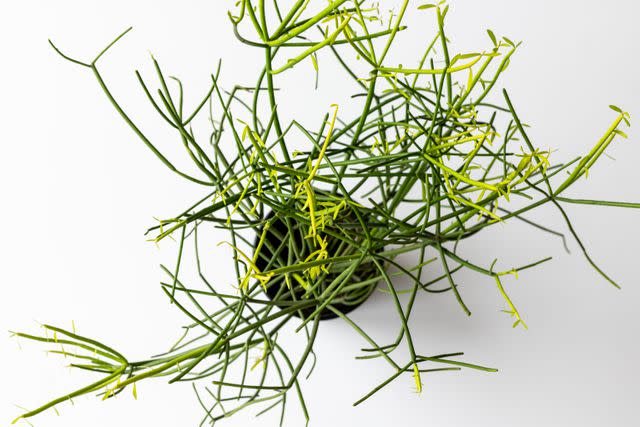
Getty Images/Bilal photos
Pencil cactus is a sprawling houseplant that grows up to 2-6 feet tall and 1-3 feet wide. Its branches stretch wide, growing pencil-like green branches at their ends. Despite its name, the fast-growing pencil cactus is not actually a cactus and doesn't have the sharp spikes associated with cactus varieties. However, it does grow small green leaves and boasts blooms that appear in spring and summer.
Name: Pencil cactus (Euphorbia tirucalli)
Light: Full sun
Water: Water a couple of times a month during warmer months and even less during colder months
Soil: Sandy, well-drained
Parachute Plant
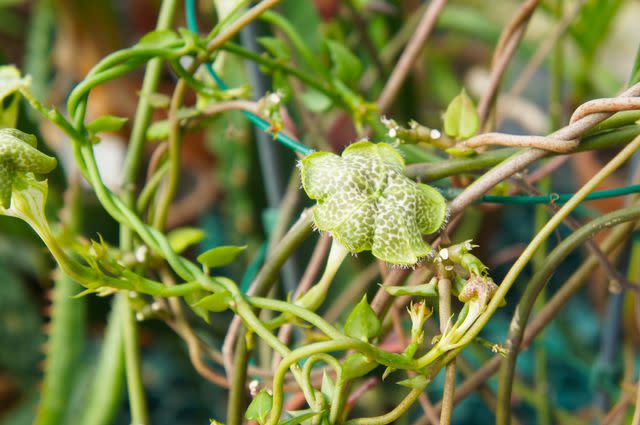
Getty Images/skymoon13
The striking blooms of the parachute plant appear throughout the summer resembling a parachute descending from the sky. These climbing plants grow best along a trellis, though it's also stunning tumbling from a hanging basket. When grown outside, the flowers attract flies into the bloom, trapping it until the flower fades. At that point, the fly is covered in pollen and goes to the next bloom, aiding in the pollinating process.
Name: Parachute plant (Ceropegia sandersonii)
Light: Indirect sunlight or filtered direct light
Water: Allow the soil to become partly dry between watering
Soil: Well-drained
Corkscrew Albuca
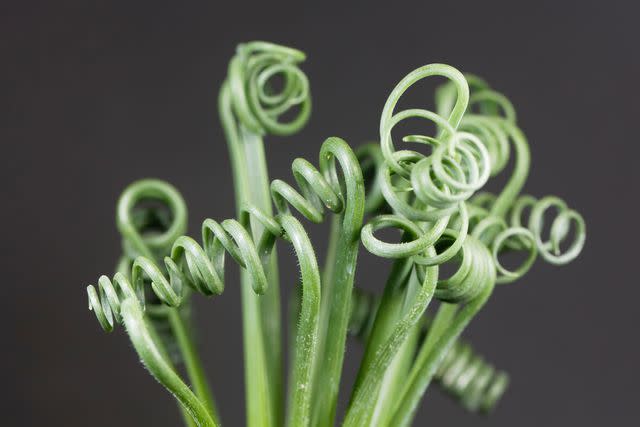
Getty Images/weisschr
Corkscrew albuca looks more like the bow on a present than a succulent houseplant. This whimsical plant's stems grow straight into the air before erupting into a tightly curled leaf. In the spring, it puts on even more of a show, sending up flower spikes with delicious-smelling yellow blooms.
Name: Corkscrew albuca (Albuca spiralis)
Light: Full sun to partial sun
Water: Allow the soil to become dry between watering
Soil: Succulent or cactus soil mix
Frequently Asked Questions
What is the rarest houseplant?
With the market of rare and exotic houseplants booming, it is difficult to pinpoint the rarest houseplant. Variegated monsteras, Monstera obliqua, Pink Princess philodendron, and some orchids certainly qualify as the rarest houseplants.
What is the easiest houseplant to care for?
The easiest houseplants are generally those that require little light, infrequent watering, and minimal other care. They include aloe vera. cast iron plant, jade plant, and snake plant.
What makes a houseplant rare?
Besides supply and demand, what makes a houseplant rare is where it grows naturally (some rare houseplants are native to inaccessible mountainous regions overseas), how difficult it is to grow and propagate, and how fast it grows.
The 15 Best Places to Buy Plants Online in 2024
Read the original article on The Spruce.

